Lili Hall
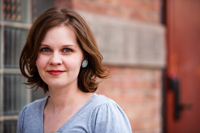
How did you get started in book arts?
I was homeschooled from about fourth grade until high school. I credit some of my start to that—it gave me time to explore things that I might not have. I was always experimenting, making piñatas and teaching myself how to make paper and that kind of thing. My sister gets credit for the rest of my start. One day she made some simple books, and that just got me going.
Because I had time to explore my interests—since I wasn’t going straight into university—I thought, “I’m just going to experiment and have fun.” I taught myself. I checked out books at the library and started mass-producing simple little books.
Early on I would improvise—I would laminate cereal boxes together or cut the boards out of binders to make book boards. I liked it so much that I started to wonder if it was just a hobby or if it was something that people did for a living. I had no idea.
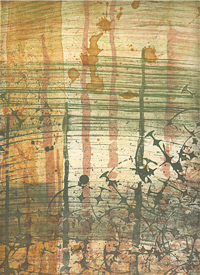
So, I started researching. That was ten years ago—there was a lot less on the Internet back then. I found a school in Colorado that taught bookbinding as an art form—what they called design binding. My mom encouraged me to apply, and I was accepted. The American Academy of Bookbinding runs in the summer, so I did one course before my mission. I loved it, and from then on, it was what I wanted to do.
A lot of people were very surprised that I was self-taught. One of my teachers said, “You’re the only self-taught bookbinder I’ve ever met.” I was registering for classes in vellum binding and I didn’t even know what vellum was. It was intimidating because I was very young and most of the people there were much older than me—a lot of people fall into it later on in life or as a second career or hobby.
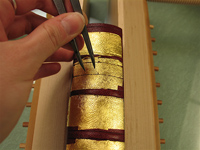
How long were you at the American Academy of Bookbinding?
I discovered that there aren’t many formal training programs. You’re required to study for five years or to do twenty bindings (ten at the school and ten on your own) that show advancement in skills. As you progress, your work is expected to reflect artistic growth. A research paper is also required of graduating students. When you’re deemed worthy, you’re given a diploma. I actually haven’t graduated yet. I’ve done four years and it’s been sort of a long-term thing—I’ve gone every second or third summer. I’ve decided that I’m not going back until I’m where I need to be for my fifth year, which is still a ways to go.
After my mission, I realized that since there’s no formal training program, I could go to college and study anything I want. I knew I wanted to do binding, so I thought, “Okay, I’ll study art.” I did and wound up falling into printmaking, which focuses on the text and imagery of books. One of my goals through my undergraduate education was to integrate what I had been studying independently and at the American Academy of Bookbinding with my printmaking diploma. My final show was my first real successful culmination of that. I hope to do more of that in the future.
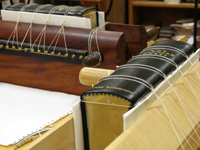
Where did the idea for your final show came from? What was it like putting it together?
I knew I wanted to produce a book, but that’s kind of broad. I was doing a diploma in printmaking—in visual art—so I knew it needed to incorporate imagery. For me, the most intimidating thing was coming up with a text. I wanted to create my own original text, but I worried about coming off as pretentious. It’s one thing creating images; it’s a whole other thing to come up with original text with corresponding illustrations. It was fairly daunting, actually, so I considered borrowing from another text. And essentially, that’s what I did. I went to the thrift store and started browsing through books, noticing that people had scribbled things in the margins.
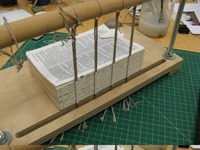
My original idea was to collect what people had scribbled there and string them together and see if I could come up with anything that was somewhat cohesive. There just wasn’t enough. In class, the idea came up of taking what people had underlined in self-help books. I went to the self-help section and discovered that those are very underlined books. I took a lot of pictures and transcribed what people had underlined. Then somewhat randomly, somewhat deliberately, I rearranged what they had written. It was an insight into a lot of people’s struggles to become more motivated. This is a bit postmodern, but I was really interested in how people’s minds work and letting them take the material and put it together.
I began to design the text. I decided to separate the phrases by inserting dingbats, little typographical embellishments. I borrowed from all kinds of fonts—traditional fonts that came from actual letterpressed broadsides, as well as some really common and almost cliché digital fonts that everyone uses, like Wingdings. The idea was for these tiny illustrations to interplay with the text and influence the way the reader interprets what was written. There was a phrase about parents, siblings, and children and there were little Star Wars dingbats inserted; suddenly your mind is assuming that the sentence was making reference to Darth Vader and Luke’s parent-child relationship.
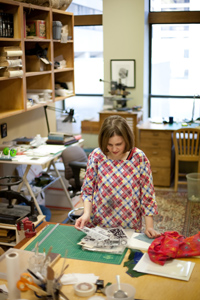
For the imagery, I wound up taking those dingbats and changing their scale and using only the lines and shapes, kind of collaging them together. I was interested in aesthetics and arrangements, in creating new spaces and environments and seeing where that took me. It was really fun to hear people’s feedback because this was a project that took me over a year. When it’s all you’re looking at, you become a bit too close to your project and you’re not sure where it stands anymore or how it’s going to be received. It’s really fun to get feedback and watch people as they look at the show and see them making their own connections. Some people made connections between the illustrations and the text and were sure that I had done something deliberate. Sometimes I had, but usually I hadn’t.
What about the letterpress part of the project?
Gutenberg books were printed by setting lead type, one piece at time. Today a lot of artists have adopted the letterpress as a printmaking medium, and some artists still collect type and set it by hand. There are also many artists who will do digital drawings or do their own hand-drawn artwork and scan it into a computer. From that they make a negative on a transparency, and from the transparency they make a photopolymer plate which has a raised surface, similar to the raised surface of type. That’s then printed on the letterpress. It’s using a traditional press with modern technologies.
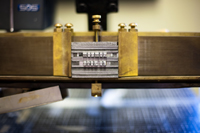
I designed the text of my book on a Macintosh in Adobe InDesign. I had a steep learning curve for that, because I’m not a graphic designer. The artwork was hand-drawn, scanned, made into negatives, and then Rob Buchert made my photopolymer plates from the negatives. I then printed my book on a letterpress from the plates.
Originally, I considered a lot of mediums. I made a lot of woodblocks and lots of prototypes, and my professors at BYU said, “These would look really good letterpressed.” That was my go-ahead. I finally settled on letterpress, and I was glad I did.

What was it like working in the BYU library conservation lab?
I knew I wanted to do bookbinding, and there is work in binding, but there’s often a lot more security in conservation. There’s not a degree in bookbinding at BYU, so I was very fortunate to meet Mark Pollei at a time when he had been working to make a student position. I was hired as a part-time conservation student and Mark became quite a mentor—he was really enthusiastic and showed me that there really are people who do this (though they’re few and far between).
Bookbinders and conservators build models. I had the opportunity to make a lot of models and study the history of bookbinding through that. I also contributed to the care of rare books. The conservation department takes care of everything in Special Collections, and so I started out making protective boxes. I got to build boxes for the original scores of Gone with the Wind and Casablanca. I also helped with library exhibitions. There are props that need to be made for books to rest on—book cradles and matting and framing and that kind of thing. I did paper repair and fixed old book posters and Japanese scrolls.
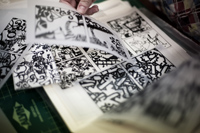
Probably the most exciting project I got to do was the conservation of a first-edition Hawaiian Book of Mormon. They’re incredibly rare. Hawaiian was one of the first languages the Book of Mormon was translated into, in the 1850s. Back then, books were printed but not all bound at once. Only 200 of the original 3,000 copies printed were not destroyed in a fire, if I understand it right. It was a good learning opportunity for me because it was a book that required being taken apart and washed—lots of very fragile paper that had been eaten by mold, leaving gaps that had to be filled in.
Tell us about woodblocks. How do you start a project from start to finish?
In my case, I wanted woodblocks that were type-high so that I could print them on a letterpress. One reason woodblocks are attractive to a lot of artists is that it’s one of the few printmaking mediums where you don’t need big equipment. Lithography and intaglio can be difficult if you don’t have access to presses—it’s hard for a lot of students who graduate to continue doing those kinds of things—but woodblocks are something you can still do.
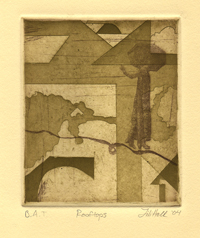
Basically, I come up with a drawing and sometimes fill it in with ink to get an idea of what the black and white might look like, and then trace the line onto the block.
The best tools will make a huge difference, so I invested in some good carving tools. They’re called gouges, and they come in different kinds of v-shapes and u-shapes. It’s helpful to have a bracing board, which is a wooden jig that hooks over the edge of a table and holds the woodblock steady while you carve.
If I’m working at home I typically use water-based inks, but I prefer the look of oil-based inks. You often get a smoother texture; the water-based ones are kind of chalky.
It’s a reductive process. You start with a flat surface and you start to dig away. It’s also called relief printing. You can test it as you go, inking it to see how it looks. You just carve until you’re happy, basically. Some of it is planned out and some of it I kind of improvise as I go along.
What was it like working on your piece “Rooftops”?
“Rooftops” was actually a school assignment. It was the early roots for the imagery of my final show—I was beginning to experiment with how shapes overlapped. With “Rooftops” I just went out and found a house and drew it, and then I took some of the architectural shapes from the house and I put them together.
This image was an intaglio print with multiple registrations. You print one plate and then you take it away and you have another plate that you’ve etched with something different and you print it in the exact same place and the images begin to overlap. I had an idea of women walking on a tightrope in this kind of imaginary architectural space. I wound up taking a vintage photograph that I had found long ago—I’m sort of an image junkie—and ended up superimposing it over the first plate with the architectural shapes.
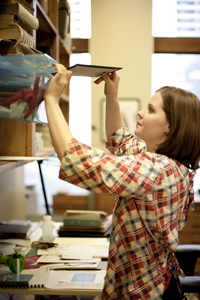
Tell us about your time at West Dean.
West Dean is a small arts school in the south of England. When I was there, there were about fifty full-time students. Its emphasis is traditional hand crafts. They have an arts school with painting and drawing, a tapestry-weaving program, an instrument making program, clock conservation and restoration, ceramics conservation, and book conservation. I first heard of West Dean because I had a friend I’d worked with at BYU who graduated from the program two years before me. There’s nothing like it available in the United States. Jumping straight from doing an art degree to doing a conservation degree was quite the reversal. All of a sudden I was studying how books and art deteriorated. I remember visiting London in 2005 and looking at paintings and thinking about their aesthetic qualities. The next time I went, while I was at West Dean, I was thinking about how the light was destroying the work. It was a completely different mindset. It’s been an interesting process figuring out how and if these two degrees work together.
I was at West Dean for one year. It’s typically a two-year program, but I started at the post-graduate level and was on an accelerated track. I worked on books from the sixteenth century. I wound up interning at the Bodleian Library in Oxford for six weeks, which was a fantastic opportunity. We studied what we called material science—mostly understanding, once again, how things break down and how materials will interact. We continued to make models and study bookbinding one day a week for a few hours. We did field trips to libraries and archives all over the south of England, and we did lots of research and writing which culminated in an independent project, which was our thesis.
I really struggled to come up with a thesis topic. I had a short amount of time to come up with it and here I was, jumping from art to conservation. I discovered that even though I’d worked at BYU, most of the materials I’d worked on were fairly modern compared to Europe. I still lacked a lot of knowledge, so I needed to work on something I already knew something about. While I was at BYU, I used to experiment with binding books in Tyvek, a modern material often used in construction. Suddenly I remembered hearing here and there of conservators using Tyvek, but essentially nothing was written about it. So, I wound up researching how it was being used by conservators. I discovered that one of the biggest problems with Tyvek was that conservators don’t think it will stick. So I wound up testing a whole bunch of adhesives with Tyvek and seeing if it stuck. The short answer was yes, it does.
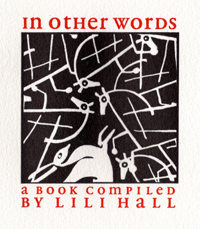
You now work at Scrub Oak Bindery. What’s that like?
Scrub Oak Bindery was founded by Ethan Ensign, who is another independent bookbinder based in Salt Lake. He has a beautiful studio and mostly does conservation work. People bring in their rare books, which, this being Utah, is a lot of early Latter-day Saint books. He also does work for dealers, who sometimes have books in parts. If the dealer can get them put back together, they’re much more likely to sell it. Ethan will also take bookbinding commissions—that’s why he called me up. With the Christmas rush, he had more work than he could do.
It’s been really educational working for a small businessman. Ultimately that’s what I hope to do. I want my own studio where I can do design binding and conservation and host classes and have a space that other people can come and use. That’s my vision. It’s been good to be around someone who’s kind of doing that.
Do you do any collaborative work?
I’ve done some collaborations with artists that have been really rewarding. One project was done with twenty-five Utah artists who all happened to be female. All of the artists were printmakers, or, if they weren’t, they had one of our printmakers convert their work to a printmaking medium. We printed thirty prints and then made thirty books containing one of each print. Then I bound them. Everyone got a book, and then one was framed in separate individual sheets and exhibited in Salt Lake and at BYU. It was a really fun collaboration; I really enjoy working with other artists, and this one was a lot less stressful than my final show because I didn’t have to do the printing and I didn’t have to do all of the art.
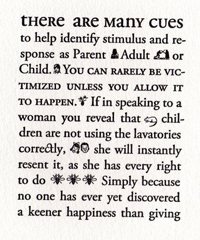
How do you see the gospel affecting your work as a book artist?
Having studied at BYU, I’ve seen it’s almost too easy to integrate the gospel into your work to the point that it almost feels cliché. For that reason, I think students sometimes steer away from that. For me, I often found that I better appreciated the gospel’s influence on my work when I would step away from the BYU setting.
One summer between semesters at BYU, I was in Colorado at my bookbinding school taking a design class. We were given a kind of an expressionism experiment where we were given words like “peace” and “disturbance” and had to create book designs based on that one word using only circles and lines (since those are common bookbinding tools). I found myself really struggling. How do you express “peace”? How do you express “disturbance”? Finally, I stepped back a little bit and thought, “Who am I? What do I believe?” That was the first time it really clicked for me how much the gospel is a part of what I create on a day-to-day basis. It was a fun experiment for me because it suddenly came easily and I was able to create my own symbolism for the word “peace.” I knew no one else would know how I found order out of these lines and shapes, but it meant something to me. I’ve come to realize that artwork can be influenced by the gospel without necessarily being illustrative or literal.
Another thing that really clicked for me was when I was reading in the scriptures and the gospel library. Whatever you study or do for a career, you want to find validation in the broader scheme of things—you want to know how your knowledge will continue. It’s fun to read about the books in heaven and think that maybe I’ll have some part in that.
I remember arriving at an “Aha!” moment, realizing that whatever creative thing it is that we’re doing—in my case it’s bookbinding and printmaking—we are learning to create. I think that’s part of our goal, if we’re really going to become like our Heavenly Father and our Savior. That really brings a lot of satisfaction. When I feel I’m doing my best, improving, and aspiring to create beauty—that’s really validating. ❧
